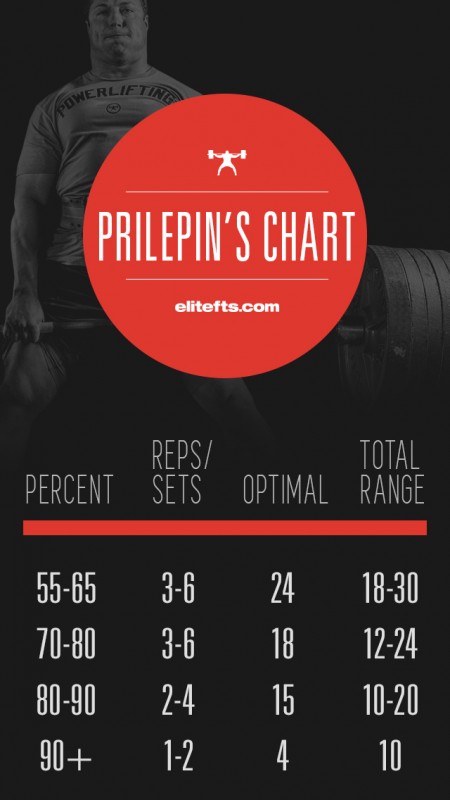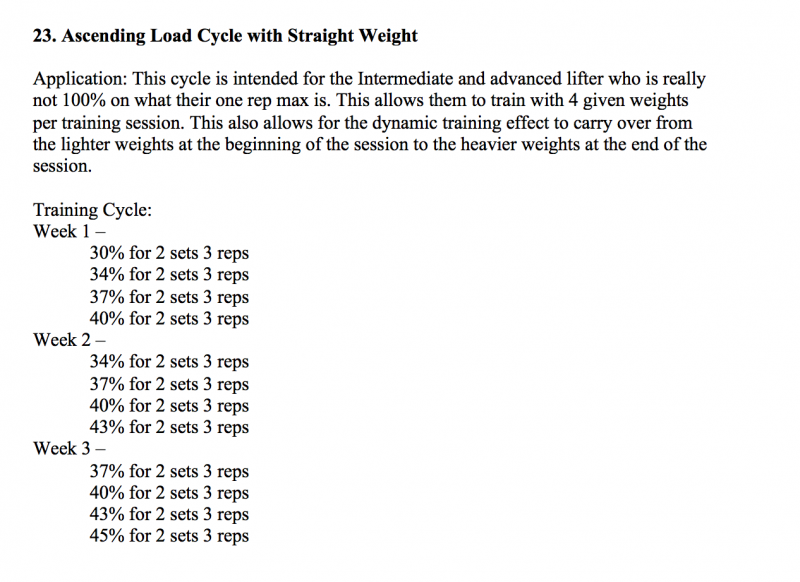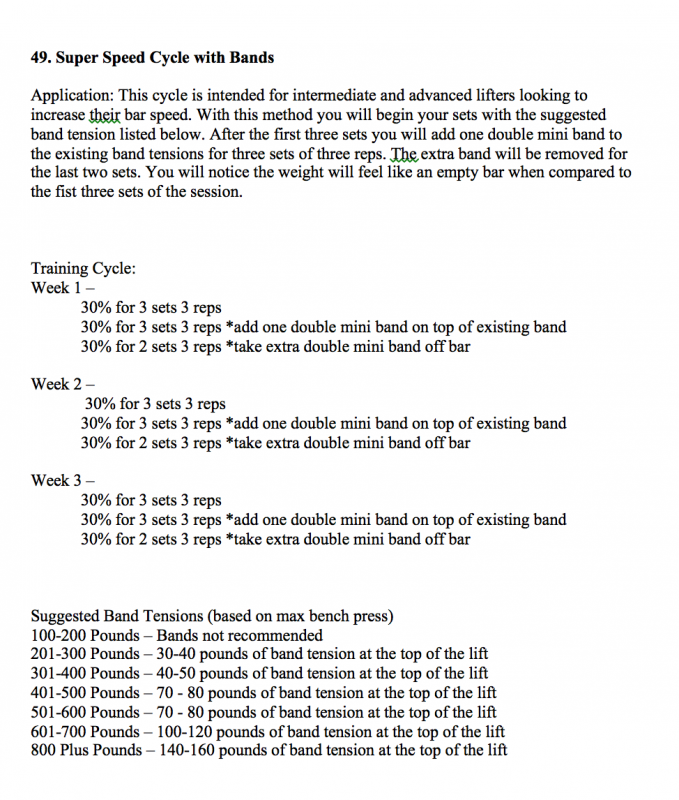
From: ELITEFTS™ BENCH PRESS MANUAL (EBOOK)
COMPENSATORY ACCELERATION
The dynamic effort method is used to train the bench press in this manual. This method is defined as lifting a non-maximal load with the greatest speed possible. This method should be coupled with compensatory acceleration. This means you must apply as much force as possible to the barbell, i.e. pushing as hard and as fast as you can in the concentric phase of the lift. If you bench press 300 pounds and are training with 200 pounds, then you should be applying 300 pounds of force to the barbell.
SUBMAXIMAL WEIGHTS
The weight used should be non-maximal in the 50% to 75% range. In the text Supertraining, Siff and Verkershonsky state the best range for developing explosive strength in the barbell squat is two-thirds of your best one rep max. Angel Spassov defines this as 50 to 70%. This method isn't used for the development of maximal strength but for the improved rate of force development and explosive force. Let's assume an athlete can only get so strong for genetic reasons. If this lifter has reached his genetic strength potential and has been stuck for five years, can he not get stronger?
GENTIC LIMITS
I was told at one time that I had reached this limit. I was told this by several university professors in the field of exercise science. What they forgot is that if I learned how to better synchronize my muscles to perform, then I could get stronger by better neural activation. The result was 300 more pounds on my total! This is because at the time I may have only been activating 50% of my absolute strength potential. Through dynamic effort training I was able to activate 70 or 80%. (The percents are used as examples, this was never tested.) This is also a reason why the percent should never be as important as bar speed. Everybody has different motor learning and the advanced strength athlete will activate more than a novice athlete. This is why the more advanced the lifter is, the harder the work is.
For example, if both athletes performed a set of 10 reps in the barbell squat with 80%, the novice would walk away like it was no big deal while the advanced athlete wouldn't be walking anywhere because he'd be on the floor! If you've followed Louie Simmons' articles over the years, you'll notice how the percents he writes for the squat and bench press have reduced over the years. This is because the gym as a whole has gotten so much stronger and more experienced. The percent for the bench press used to be around 70, now it's around 45 to 55%. Many have asked how this can be. Well, as stated above the athletes are now recruiting more motor units than before so less percent is needed to produce the desired results.
Rule #1 - The best way to determine what your training percent should be is to begin with 50% and have someone videotape your bar speed. If you can maintain this bar speed then increase the percent. When the bar slows down then decrease the percent.
These dynamic days are to be done 48-72 hours after the max effort day (or your normal bench day) to allow for proper recovery. The training scheme for the dynamic days begins with plenty of warm-up sets and progresses onto the work sets. For the bench press, use 8 sets of 3 reps are used for most cycles. There are many reasons for this set and rep structure.
EIGHT SETS OF THREE
The first reason is because of Prilepin's charts (see below). Prilepin studied weight lifters to see what the optimal number of reps in each intensity zone should be. Louie Simmons (Westside Barbell Club) applied this research into the training of the power lifts. At the time the bench press was being trained in the 70% range.
This would equate to an optimal number of 18 lifts for the bench press in a range of 12 to 24 reps, and 15 lifts for the squat in a 10 to 20 rep range. He decided on two reps for the squats and three reps for the bench press because of time specificity of the competitive lifts. The time to unrack the weight to the completion of the lift in competition came out very similar to two reps in the box squat and three reps in the bench press.
The second reason for this set and rep structure is because it has stood the test of time and has worked over and over again without flaw. This has created an evolving system where the optimal number of lifts has remained 24 for the bench press for weights under 80%.
WARMING UP
The bench press workout should begin with a light general warm-up consisting of upper body sled work and warm-up exercises for the bench press. These can include light shoulder raises to the front, side and rear, as well as some light triceps extension or pushdown movements. After the warm-up you'd move onto the actual bench press movement.
Begin with the bar for as many sets as necessary to feel loose and warmed up. Increase the weight with 20 or 50 pound jumps depending on your strength level and begin the dynamic work sets with whatever the prescribed percentage is for the day. You'll perform 8 sets of 3 reps in a dynamic fashion. These reps should be performed with compensatory acceleration. The rest between sets should be 45-60 seconds.
The goal of this is to fatigue the fast twitch muscle fibers. These are the fibers responsible for explosive strength and power. We want these muscle fibers to become fatigued so over time they'll adapt and become stronger. The other reason is that the more you fatigue, then the more fibers will become activated with each set. A fatigued muscle fiber won't work as well, so the body will activate more and more muscle fibers to complete the workout. A one-minute rest constitutes about a 1:6 work to rest ratio and anything over 1.5 minutes will defeat the training effect.
SUPPLEMENTAL MOVEMENTS
When you finish the bench press movement, you'll move onto the supplemental exercise for the day. This exercise should be some type of tricep press or extension movement. The best ones for this purpose are the close grip bench press, JM press, barbell extensions or dumbbell extensions. The intensity should be high and the volume low. We've found sets in the range of two to four with 3 to 8 reps to be excellent. These sets are started after all warm ups for the exercise have been completed.
ACCESSORY MOVEMENTS
The accessory exercises that follow should include movements for the shoulders and lats. These movements should be of moderate intensity for intermediate rep ranges. This may be three to five sets of 8 to 15 reps. You should leave one or two reps at the end of every set. This means you won't go to failure, which will ensure proper recovery for the next workout. Upon completion of these movements you'll move onto prehabilation work consisting of external rotation moments for the shoulders and light pushdowns and or light sled work for the upper body.
READ: Guide to Supplemental movement Training Article
BLOWING YOUR BENCH UP
The reason I selected these two cycles is I do not believe the percents have to change at all if your are raw or geared, expecially if you remember rule #1 listed above. This would be your second bench day of the week. Your first day would be your normal bench day or traditional max effort training. These cycles are screen shots from the manual so you can click on the cycle to increase the resolution.
Click Here For Bands













1 Comment